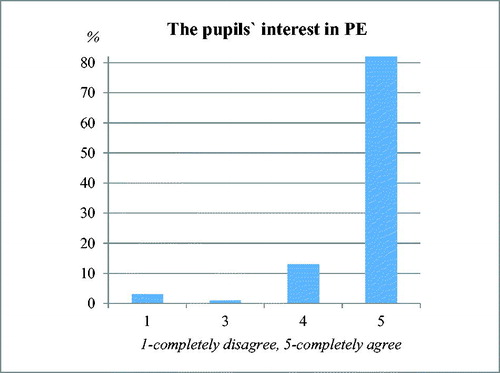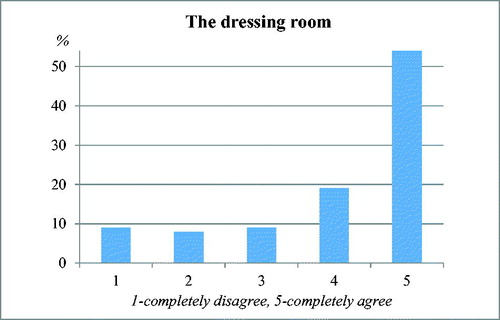Abstract
The topic of this paper are the material working conditions in Physical Education as a very important part of the educational process which is successfully conducted with appropriate exercising equipment, props and premises in which exercising takes place. The aim of this paper was to study the state of material working conditions in all primary schools in Pula. The research was conducted among 99 primary education teachers using an anonymous questionnaire that consisted of 14 variables. It examined the opinions of the teachers, their agreements and disagreements through a five-degree Likert scale. Based on the obtained results, it can be concluded that the main problem in primary schools in Pula is a lack of exercising equipment and props needed to work in Physical Education. Furthermore, gyms are not sufficiently available for classroom teachers because subject teaching has precedence over them.
Introduction
‘Physical Education has to be one of the foundations of the whole population’s health, and is important for the creation of whole personalities, healthy and satisfied pupils’ (Ministry of Science, Education and Sport, 2016, p. 4). The subject Physical Education thus supports the acquisition of knowledge, skills and habits which form a positive attitude toward physical exercising and a healthy way of life (Ministry of Science, Education and Sport, 2016).
Today children move less due to the sedentary way of life at school, but also the time spent in front of computers at home. Therefore, it is necessary to conduct Physical Education regularly. It should be well conceptualized and conducted to be able to teach children how to do individual exercises and include physical activities in their everyday life. Moreover, school time is the age at which children’s characteristics, abilities, motor knowledge and health can be mostly influenced, so frequent exercising is necessary (Vrbanac & Palijan, 2009).
The teachers’ role is crucial for the conduction of quality Physical Education teaching, since they are the ones who decide how a Physical Education class is going to be conducted. They have to be motivated and creative, and have a positive attitude toward physical exercising to be able to transfer it to pupils. They should also know how to use the available space and equipment in Physical Education teaching. Material working conditions in Physical Education are exactly one of the most serious problems of education in the Republic of Croatia.
The results and success of Physical Education largely depends on material conditions. A large number of schools in the Republic of Croatia do not have the basic conditions for the conduction of Physical Education. Some schools do not have gyms, others do not have exercising equipment and props. What also represents a problem is the availability of the gym to classroom teachers which prevents the conduction of the curriculum prescribed by the Ministry of Science and Education (Šunda, Tvorek, Nabršnigg, and Knjaz, 2011).
The Physical Education teaching process depends on the goals and tasks which can be achieved by various aids and methods, but also on material working conditions for the organisation and conduction of teaching. ‘The conduction of any form of physical exercising in inadequate spaces, with defective and inappropriate equipment, without tools and aids, cannot guarantee a successful conduction of the curriculum or the fulfilment of aims and tasks of the physical education area’ (Findak, Citation1999, p. 261). Material working conditions are very important, but not crucial, because the teaching process mostly depends on the teachers’ knowledge and capabilities to use the available space, equipment and aids. Teachers have to take care about the spatial and weather conditions of the conduction of teaching and about the extracurricular and out-of-school activities. Physical Education can be conducted outdoors, indoors, on snow, ice and water. Pupils are exposed to external factors, so the teacher has to take care of that, too. Findak (Citation1999) divides tools, i.e. exercising equipment, aids and props to standard, those also used in other subjects, and non-standard, those used only in Physical Education. ‘Material learning and teaching conditions in Physical Education include various tools, props and aids for physical exercising, professional literature, the daily press, television, internet and other available communicational resources’ (National Curriculum of Physical Education, 2016, p. 83).
Material working conditions for Physical Education are constituted and defined by premises, equipment and tools. ‘The kinesiological activity premises are spaces defined and arranged by construction works, their size and processing should be in line with requirements of certain kinesiological activities with the purpose of a safe and humane use of the premises, regardless of the weather or climatic conditions of the environment’ (Findak, Citation1999, p. 262). There are open and closed facilities in which Physical Education, extracurricular and out-of-school activities are conducted (Findak, Citation1999).
Outdoor standard facilities include the playground, athletic track, jumping facilities, throwing facilities, open green spaces, polyvalent training grounds, swimming pools and polygons. Outdoor non-standard facilities are natural swimming premises, sledge runs, ski runs, skating rinks and other appropriate grounds. The size of outdoor facilities depends on their purpose, and in the conduction of Physical Education it is important that pupils can work smoothly and safely, that the curriculum contents are realised and that they meet the health and hygienic conditions.
Indoor facilities include physical education gyms, swimming pools and appropriate adapted exercising premises and rooms. One of the most important indoor facilities is the gym since it enables a continuous conduction of Physical Education, regardless of weather conditions. Whenever weather conditions are good it is necessary to conduct Physical Education outdoors. There are gyms of various sizes and with various numbers of auxiliary rooms, with different equipment and aids which need care with regard to their proper operation, deterioration, cleanliness and maintenance. In schools which do not have a gym, or when gyms are busy, or the weather conditions are bad, it is possible to conduct Physical Education in adapted rooms, namely classrooms, which offer safety to pupils and teachers and meet the basic hygienic working conditions (Findak, Citation1999).
‘Equipment is an incorporated or movable element or content equipping activities, contrary to technical equipment with the help of which external conditions for activities are created’ (Findak, Citation1999, p. 263). Equipment includes exercising equipment and props which support exercising and thanks to which physical exercising is conducted or controlled.
Exercising apparatus represents elements on which physical activities are conducted. Mats, Swedish ladders, high and low beams, Swedish benches, gymnastic horses, Swedish boxes, springboards, climbing ropes, marina ladders, parallel bars, flying rings, steady rings and many others are used in Physical Education. The use of this exercising equipment depends on the pupils’ age, class, conducted programme, as well as on the number of pupils and the level of pupils’ motor knowledge and achievement.
Props are objects necessary to pupils for exercising or competitions and are used in almost all organisational forms of work in Physical Education. They are used both in open and closed facilities, in almost all parts of a class, and they can be balls, medicine balls, short and long skipping ropes, hoops, sticks, spheres, strips, poles, sand bags, percussions, targets, ice skates, sledges, skis and others. When certain props are chosen for programme contents, care should always be taken for them to be adequate regarding their weight and size to the pupils’ age. For some programme contents each pupil has to have his or her own prop, in other it is sufficient for two or more pupils to use one prop.
The auxiliary-technical means used for an easier organisation of works are also part of the equipment. The auxiliary-technical means are the stopwatch, centimetre tape, altimeter, balance, callipers, stalks, flags, whistle, computer, motor abilities measuring tools and other means used to mark the terrain, exercising facilities, pupils during play, assessment or to give first aid. The computer is more and more used since it helps to find precise and reliable data about the teaching process results.
Physical Education teaching is also influenced by teaching tools which can be visual, auditive, audio-visual and textual. Thanks to them and the teaching technique with demonstration pupils master new motor movements faster, due to their thoroughness which they would not notice during live demonstrations. Pupils thus understand better and become more interested and motivated for work. Besides, teaching tools can be used to obtain additional information, or motor movement details and thus fulfil pupils’ knowledge.
Teachers have to choose the adequate material and sources adapted to pupils’ age and characteristics, and using different work forms teach them theoretical and motor knowledge, as well as develop a positive attitude towards physical exercising. Teachers should incite pupils to engage in physical exercising which should be kept as a permanent value. They should conduct it in a safe way with regard to the material working conditions in which Physical Education teaching is conducted (National Curriculum of Physical Education, 2016).
Research aim
The aim of this research was to determine the state of the material working conditions in Pula primary schools for the needs of Physical Education in classroom teaching.
Methods of work
Sample of respondents and variables
The questionnaire was conducted using an anonymous questionnaire inspecting the state of the material working conditions for the conduction of Physical Education in all primary schools of Pula, and it encompassed as many as 97 female and 2 male classroom teachers.
The questionnaire used for the conduction of the research consists of two parts. The first part relates to the respondents’ general data (sex, age, number of years of service, the grade he/she teaches), while the second part consists of 14 statements about the material working conditions for the Conduction of Physical Education in their schools. The last question was about the teachers’ opinion about the improvement of material working conditions in their schools.
Teachers expressed their opinion, or attitudes on a Likert-type scale with levels 1 to 5. The scale consists of five levels revealing teachers’ attitudes, i.e. agreement or disagreement with statements: 1 – completely disagree. 2 – mostly disagree, 3 – neither agree, nor disagree, 4 – mostly agree, 5 – completely agree.
Data processing method
The basic descriptive parameters have been calculated for each variable. The obtained results were processed by the software package Statistica for Windows 13.
Research conduction method
The research was conducted during May and June 2018 with classroom teachers from all Pula primary schools (Republic of Croatia) participating in it. The samples were collected by personal contact, and the respondents were familiar with the aim and purpose of the research.
Results and discussion
and figures presenting each single statement show the research results and indicate a lack of exercising equipment and props necessary for the conduction of Physical Education.
Table 1. Questionnaire results about the material working conditions in schools.
The obtained results show that most teachers completely agree on the fact that they regularly conduct Physical Education classes, namely 80% of them, while 3% of teachers completely disagree with this statement. There are 14% of teachers who say that they conduct Physical Education classes almost regularly, while 2% of them say that they do not conduct Physical Education classes regularly (). Pavičić (Citation2016) argues that the school subject Physical Education is a kind of pastime for lower grade pupils, and to both teachers and parents it has become a normal notion that Physical Education is not important. According to the first statement results, i.e. the regularity to which Physical Education classes are conducted, classroom teachers from Pula respond that more that 80% of them conduct Physical Education classes regularly, while 5% of them do not. It is extremely significant and useful that the majority of teachers conduct classes regularly, but still there should not be any, even minimal, percentage of those who do not. Physical Education classes are the only form of children’s organised exercising in some parts of the Republic of Croatia and are therefore significant. There are more and more children and young people who do not have sufficient movement, but sit in front of their computers for a long time and live an unhealthy life. Teachers are those who have to motivate and encourage pupils to engage in physical exercising for it to become a constituent part of spending their free time.
The second variable results show that only 7% of teachers completely agree with the statement that each of their Physical Education classes is conducted in the school gym. As many as 23% of teachers do not at all, or mostly do not, conduct each Physical Education class in the school gym, 28% of them do and 18% of them have a shared opinion on that. There are 35% of teachers who claim that they conduct each Physical Education class in the school gym, although 46% of them do not agree with this statement (). A reason for that could be found in the lack of school gyms or the availability of school gyms in the Republic of Croatia. It is confirmed by Pavičić (Citation2016) who mentions smaller settlements and towns which do not have even the basic working conditions for Physical Education teaching and teachers do not have the possibility of conducting a class in the school gym. As regards Pula, classroom teachers do not have a sufficient availability of the gym because precedence is given to subject teachers, and that is the reason of their not conducting Physical education classes in the gym at all.
Figure 2. Teachers’ attitudes about the conduction of each Physical Education class in the school gym.
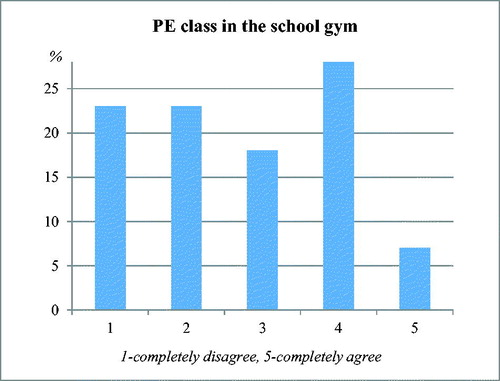
The obtained results indicate that 3% of teachers claim that pupils are not at all interested in Physical education, while 1% of them have a shared opinion on that (). The results are very positive for this statement (more than 93% of them state that pupils have an interest in Physical Education). Considering the pupils’ interest in Physical Education, more than 80% of teachers agree that children also show an interest in physical exercising. The herein stated was confirmed by the scientific paper written by Biletić, Benassi, Baić, Cvetković, and Lukšić (Citation2008) according to which out of a total of 610 male and female pupils, 59.9% of them have an expressed positive attitude toward Physical Education.
presents the obtained results of teachers’ attitudes about the size of the gym for the conduction of classes indicating that 22% of the teachers think that the gym in the school they work in is not big enough for the conduction of Physical Education classes in classroom teaching. As many as 59% of teachers think that their gym is big enough for the conduction of a Physical Education class, 14% of them mostly agree, while 4% of them do neither agree nor disagree. A reason for that can be found in the fact that some schools, due to their location, do not have enough space to build a big school gym.
Figure 4. Teachers’ attitudes about the sufficient size of the gym in their schools for the conduction of Physical Education classes in classroom teaching.
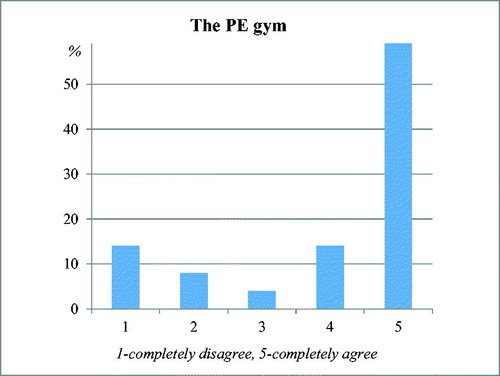
A large number of teachers claim that in their school pupils have an adequate place (dressing room) to change and wear the necessary clothes and footwear (54%). There are 19% of teachers who mostly agree with that statement, while 17% of them think that pupils do not have an adequate dressing room ().
The results obtained for variable 6 indicate that 18% of teachers completely disagree with the statement in their school gyms there is a sufficient number of exercising equipment and props, 20% of them mostly disagree, while 23% of them mostly agree and 19% of teachers completely agree with the statement about the sufficient number of exercising equipment and props. There are 19% of teachers who cannot make up their minds, and they neither agree nor disagree (). The results are not satisfactory, so more should be invested into The Physical Education equipment. According to Šunda et al. (Citation2011), if Physical Education classes are conducted in adequate material and technical conditions, the pupils’ achievement and results will be better than if physical exercises is conducted in poorer conditions such as inadequate premises without equipment and props.
Figure 6. Teachers’ attitudes about the sufficient number of exercising equipment and props in the school gym.
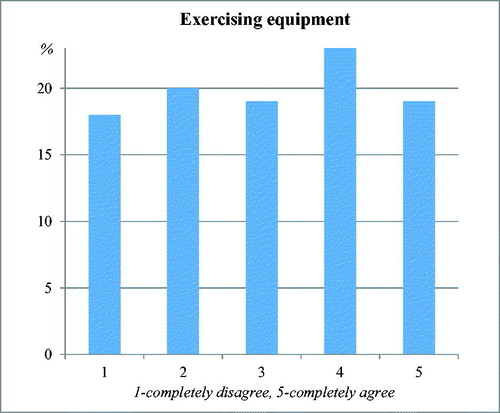
Results show that most teachers are of the opinion that school gyms in schools they work in have all the necessary equipment and props (36%). However, the rest of the teachers think that their gyms do not have all the necessary equipment and props (44%), while 19% of teachers cannot decide (). The data about teachers’ attitudes show more negative than positive results, so schools should invest more in exercising equipment, props and Physical Education working equipment. Something similar is confirmed by the research conducted by Šunda et al. (Citation2011) which defines that pupils who did not have equipment and props in primary school meet some of them for the first time when they enrol to high school and are thus afraid of the unknown so it is very difficult to conduct and perform certain teaching topics in that period of time.
Figure 7. Teachers’ attitudes about all the necessary exercising equipment and props necessary to work in their school gym.
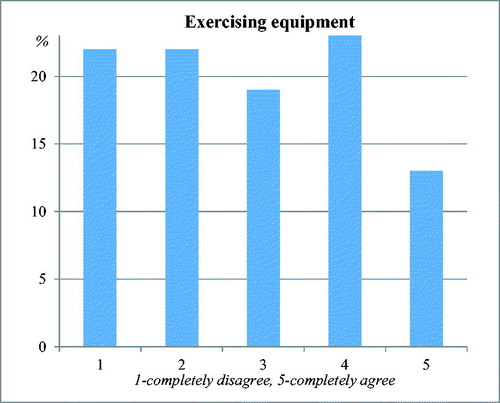
Results shown in show that teachers think that purchasing equipment and props to work in the gym is necessary. As many as 56% of teachers consider that they should get more equipment for Physical Education, while 28% of them mostly agree with that statement. There are 8% of hesitant ones, while only 4% of them think that more equipment is not necessary and 3% who mostly think that their purchase is not necessary. Therefore, most Pula primary schools need investments in equipment for a better quality of teaching and better children and young people’s results.
Figure 8. Teachers’ attitudes about the need to procure more exercising equipment and props to work in the gym.
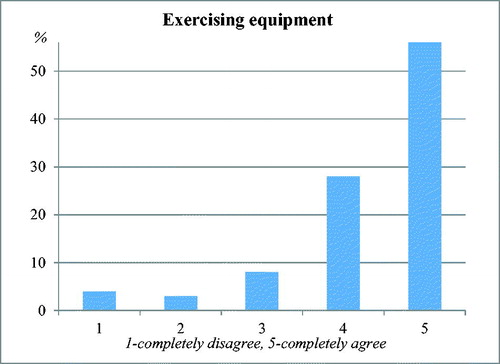
There are 5% of teachers completely disagreeing that exercising equipment and props necessary for Physical Education are always available, and as many as 18% of them think that they are mostly not available; 18% of them think that the equipment is neither unavailable nor available, and 31% of them see it as mostly available. The rest of the teachers are of the opinion that exercising equipment and props are always available (27%) (). A possible reason for that can be subject teaching which has precedence over classroom teaching due to more complex and demanding teaching topics. Subject teaching is usually held in the morning shift so lower grade teachers are not able to conduct Physical Education classes in the gym, but they take the available props and spend the class at the playground.
Figure 9. Teacher’s attitudes about the availability of exercising equipment and props necessary for Physical Education classes.
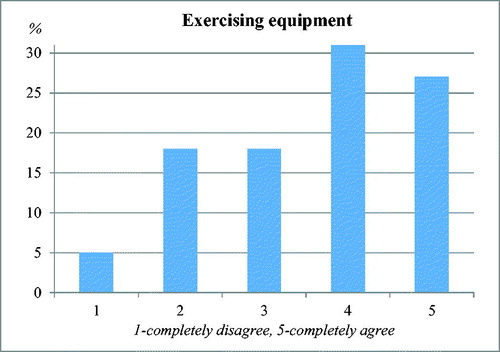
shows that most teachers (70%) think that they try to conduct an optimal Physical Education class when exercising equipment and props are not available, 24% of them claim almost the same, while 2% of them do not try to conduct Physical Education in an Optimal manner. The remaining 2% of teachers do neither agree nor disagree with this statement. According to Šunda et al. (Citation2011) teachers are those who have to be creative and motivated for the realisation of the best possible Physical Education class, especially when they are in a harder position and do not have the possibility to do certain teaching topics due to a lack of exercising equipment and props.
Figure 10. Teachers’ attitudes about the effort to conduct an optimal Physical Education class when exercising equipment and props in the school gym are not available.
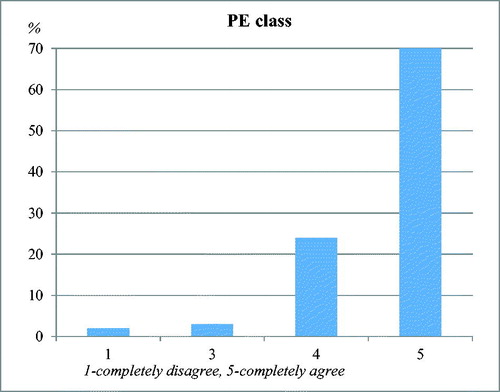
The 11th variable results indicate that somewhat more than half of the respondents (52%) consider themselves trained enough to conduct Physical Education teaching in a quality way. There are 30% of teachers who think that they are mostly competent to conduct Physical Education well, 4% of teachers are of the opinion that their competences are insufficient for the conduction of good Physical Education classes, while 13% of them have a shared opinion on that (). The teachers’ role is crucial because they conceive Physical Education classes and should know best how to use the available space, exercising equipment and props. That is the reason why they need to have all the necessary competences to conduct Physical Education well, and in that sense more than 80% of teachers consider themselves mostly or completely competent to conduct Physical Education well.
Figure 11. Teachers attitudes about their competences necessary for conducting Physical Education well.
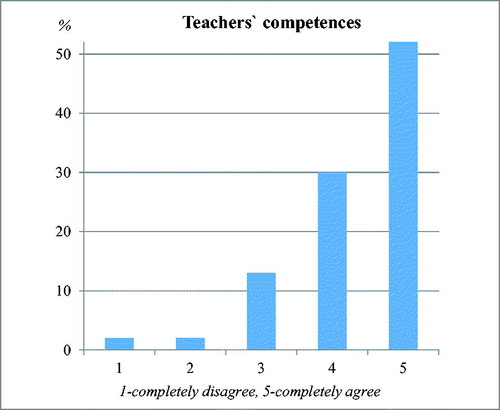
In the 12th variable analysis it can be noticed that 53% of teachers try to conduct Physical Education at the playground as much as possible, meaning outdoors in fine weather. As many as 30% mostly spend classes outdoors, but 11% neither do nor don’t spend classes outdoors. The percentage of teachers who do not try to spend Physical Education classes outdoors in fine weather is small (5%) (). Those results were expected considering the fact that certain curriculum topics cannot be performed outdoors since to perform them one needs exercising equipment and props found indoors, in the school gym. But it is useful and healthy to conduct Physical Education classes outdoors as much as possible.
Figure 12. Teachers’ attitudes about their effort to spend most Physical Education outdoors in fine weather.
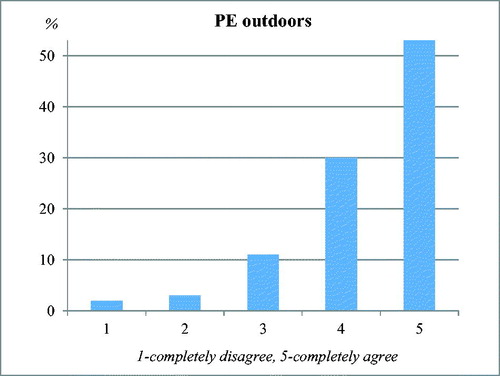
Results shown in show that most teachers (32%) sometimes make an analysis of the training ground condition and the defective and worn-out exercising equipment and props. It can be seen that even 52% of teachers do not check the training ground and equipment condition. Only 24% of teachers agree with this statement, i.e. perform that duty. One of the possible reasons for that is that classroom teachers do not consider themselves responsible, and that this is the subject Physical Education teachers’ responsibility.
Figure 13. Teachers’ attitudes about the annual analysis of the training ground condition and listing the defective and worn-out exercising equipment and props.

According to more than 30% of teachers mostly think that the school they work in makes sufficient investments for the purchase of props and exercising equipment for the conduction of Physical education, while 4% of them do not agree with that at all. There are 16% of teachers who completely agree, while 19% of them mostly disagree. Those who cannot decide if their schools do or do not invest sufficient means in purchasing Physical Education equipment make 29% of them all. The work done by Šunda et al. (Citation2011) mentions that it is necessary to support the construction of sports facilities, but also the use of various props which are new and more interesting to pupils, that such props do not represent a large expenditure, and that the construction and equipment of gyms should be the society’s obligation.
Figure 14. Teachers’ attitudes about their schools’ investments for the purchase of good exercising equipment and props necessary for the conduction of Physical Education.
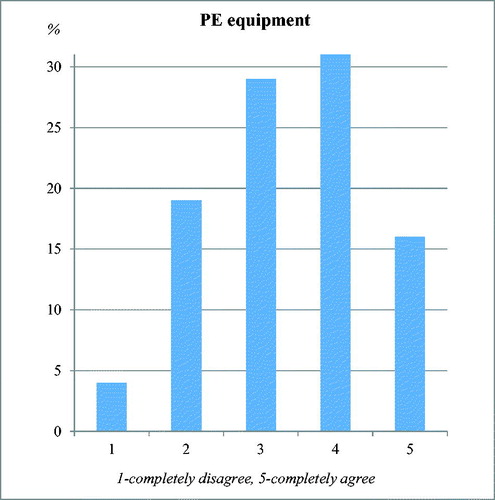
The last question in the questionnaire was about the teachers’ opinion of the possibilities of material working conditions improvement regarding the school they work in, and 44% of them gave an answer to this question. Most of them think that new exercising equipment and props for the conduction of Physical Education should be purchased, while a few of them think that a new gym should be built. Moreover, they are of the opinion that the gym should be more available for the conduction of Physical education in the morning shift and that old an worn-out exercising equipment and props should be replaced. Many teachers claim that the gym is not available for classroom teachers, except when it is agreed with Physical Education teachers, and that they are not well equipped for Physical education classes. Many of them think it is necessary to procure larger amounts of money for new equipment and that it is possible to do that through donations, projects or by saving part of the money for that purpose.
Conclusion
Based on obtained results it can be concluded that in Pula primary schools there is a lack of exercising equipment necessary for the conduction of Physical Education classes. More than half (56%) of teachers are of the opinion that it is necessary to purchase more exercising equipment and props to work in the gym, and only 18% claim that their school’s gym has enough exercising equipment and props. It is necessary to put apart a fund to finance new exercising equipment and props because without them it is impossible to conduct good Physical education classes. The advancement and development of pupils is possible, but hardly without appropriate exercising equipment and props.
Regarding the regularity of Physical Education conduction, 80% of teachers agree with the statement, and more than 59% think that pupils have a real interest in Physical education. That the gym is sufficiently big for Physical Education is the opinion of 59% of lower grade teachers, and 54% of them think that pupils have an adequate place to dress and wear the necessary clothes and footwear. The Physical Education premises are, thus, of acceptable size, but the same cannot be said about their availability for classroom teachers. Many have given an answer to the last questionnaire question in the sense that subject teaching Physical Education classes have a precedence over classroom teaching, so the gym is not always available. What is necessary in this sense is a very good organisation of subject and classroom teaching timetables for both sides to gain, i.e. have an available gym.
The analysis of the training ground condition and assessment of the exercising equipment and props are conducted by only 12% of teachers, which is a low percentage. Teachers are responsible for the child’s safety, especially during Physical Education classes so they have the obligation to check the defective and worn out exercising equipment and props.
This research results could be relevant to teachers, head-teachers and all those who are responsible for the area of children’s education with the aim to improve the material working conditions and have an optimal development and advancement of children, not only in Physical Education, but children as whole, healthy and satisfied persons.
Disclosure statement
No potential conflict of interest was reported by the authors.
References
- Biletić, I., Benassi, L., Baić, M., Cvetković, Č., i Lukšić, E. (2008). Stavovi učenica i učenika osnovnih škola Šijana u Puli i Poreču prema nastavi i nastavnim cjelinama tjelesne i zdravstvene kulture. Zbornik radova 17. ljetne škole: Stanje i perspektiva razvoja u područjima edukacije, sporta, sportske rekreacije i kineziterapije. str. 82.-87. Retrieved from https://www.hrks.hr/skole/17_ljetna_skola/81-87.pdf
- Findak, V. (1999). Metodika tjelesne i zdravstvene kulture. Zagreb: Školska Knjiga.
- Ministry of Science, Education and Sport. (2016). National Curriculum of Physical Education. Zagreb: Ministry of Science, Education and Sport. Retrieved from http://mzos.hr/datoteke/18-Predmetni_kurikulum-Tjelesna_i_zdravstvena_kultura.pdf
- Neljak, B. (2011). Kineziološka metodika u osnovnom i srednjem školstvu. Zagreb: Skriptarnica SKIF na Kineziološkom Fakultetu.
- Pavičić, D. (2016). Nastava tjelesne i zdravstvene kulture u školama ruralnih krajeva. Zbornik radova 25. ljetne škole: Kineziologija i područja edukacije, sporta, sportske rekreacije i kineziterapije u razvitku hrvatskog društva. str. 678.-681. Retrieved from https://www.hrks.hr/skole/25_ljetna_skola/678-Pavicic.pdf
- Šunda, M., Tvorek, A., Nabršnigg, K., i Knjaz, D. (2011). Kolika je realna mogućnost provođenja nastavnih tema tjelesne i zdravstvene kulture u školama u Republici Hrvatskoj? Zbornik radova 20. ljetne škole: Dijagnostika u područjima edukacije, sporta, sportske rekreacije i kineziterapije. str. 511.-514. Retrieved from https://www.hrks.hr/skole/20_ljetna_skola/511-514-Sunda.pdf
- Vrbanac, D., i Palijan, T. (2009). Nastava tjelesne i zdravstvene kulture kao temeljni organizacijski oblik rada u školi. Zbornik radova 18. ljetne škole: Metodički organizacijski oblici rada u područjima edukacije, sporta, sportske rekreacije i kineziterapije. str. 528.-535. Retrieved from https://www.hrks.hr/skole/18_ljetna_skola/528-535.pdf


